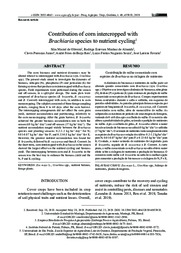Contribution of corn intercropped with Brachiaria species to nutrient cycling.
Contribution of corn intercropped with Brachiaria species to nutrient cycling.
Autoria: OLIVEIRA, S. M. de; ALMEIDA, R. E. M. de; PIEROZAN JUNIOR, C.; REIS, A. F. de B.; SOUZA, L. F. N.; FAVARIN, J. L.
Resumo: The corn biomass and nutrient dynamics may be altered when it is intercropped with Brachiaria (syn. Urochloa spp.). The present study aimed to investigate the dynamics of biomass, nitrogen (N), phosphorus (P) and potassium (K) for farming systems that produce corn intercropped with Brachiaria species. Field experiments were performed during the season and off-season, in a split-plot design. The main plots were composed of Brachiaria species (B. brizantha, B. ruziziensis and B. Convert) intercropped with corn, in addition to corn monocropping. The subplots consisted of three forage sampling periods, ranging from 0 to 60 days after the corn harvest. The intercropping arrangements did not affect the corn grain yield, nutrient accumulation and partitioning, relatively to the corn monocropping. After the grain harvest, B. brizantha achieved the greater biomass accumulation rate in both the season (69 kg ha-1 day-1) and off-season (17 kg ha-1 day-1). The nutrient accumulation ranged widely between the Brachiaria species and planting seasons: 0.2-1.2 kg ha-1 day-1 for N; 0.01-0.07 kg ha-1 day-1 for P; and 0.13-0.8 kg ha-1 day-1 for K. However, the greatest nutrient accumulation was found for B. brizantha, followed by B. ruziziensis and then B. Convert. In the short-term, corn intercropped with Brachiaria in the season showed the largest effect on the nutrient cycling and biomass yield. The intercropping between corn and B. brizantha in the season was the best way to enhance the biomass yield and the N, P and K cycling.
Ano de publicação: 2019
Tipo de publicação: Artigo de periódico
Unidade: Embrapa Pesca e Aquicultura
Palavras-chave: Brachiaria, Capim Urochloa, Corn, Forage, Milho, Nutrient balance, Nutriente, Planta Forrageira, Zea Mays
Observações
1 - Por padrão são exibidas publicações dos últimos 20 anos. Para encontrar publicações mais antigas, configure o filtro ano de publicação, colocando o ano a partir do qual você deseja encontrar publicações. O filtro está na coluna da esquerda na busca acima.
2 - Para ler algumas publicações da Embrapa (apenas as que estão em formato ePub), é necessário ter, no celular ou computador, um desses softwares gratuitos. Sistemas Android: Google Play Livros; IOS: iBooks; Windows e Linux: software Calibre.
Acesse outras publicações
Acesse a Base de Dados da Pesquisa Agropecuária (BDPA) para consultar o acervo completo das bibliotecas da Embrapa.

